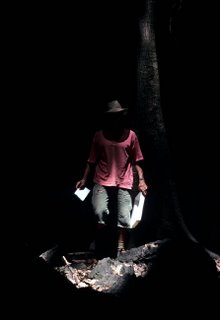 I hadn't been to Irvinebank for about 15 years. The last time I was there, I'd been on a field trip to the limestone caves at Chillagoe – Mungana National Park. My b/f at the time and I had been looking at the small scale distribution of limestone-associated microsnails. We never got around to publishing the work. (Just to prove we did something, here's his lordship at the study site.)
I hadn't been to Irvinebank for about 15 years. The last time I was there, I'd been on a field trip to the limestone caves at Chillagoe – Mungana National Park. My b/f at the time and I had been looking at the small scale distribution of limestone-associated microsnails. We never got around to publishing the work. (Just to prove we did something, here's his lordship at the study site.)But I digress.
Irvinebank is about 30 kilometres west of Herberton on a well-made, picturesque gravel road. (A well-made, picturesque gravel road with a very, very soft shoulder, as I discovered when I stopped to take a photograph of the flowering Grevillea pteridifolia.)
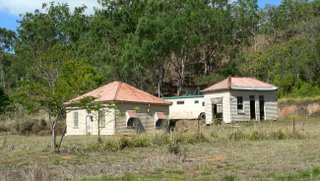 The town has a population of 85, which makes it a metropolis compared with neighbouring Watsonville. There's a pub and a few other things. But let's face it, if the town's got a pub, the locals don't need much else.
The town has a population of 85, which makes it a metropolis compared with neighbouring Watsonville. There's a pub and a few other things. But let's face it, if the town's got a pub, the locals don't need much else.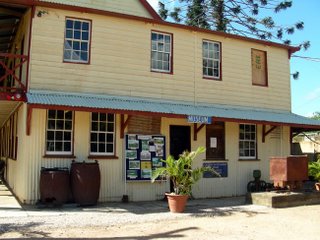 Irvinebank is an old tin-mining area. Following the discovery of tin at Herberton, miners scoured the region for other sources, both lode and alluvial. Magnate John Moffat moved his business to Irvinebank, where he established a smelter to process the metal. Moffat's home—the oldest two-storey building in North Queensland—is now the Loudoun House Museum.
Irvinebank is an old tin-mining area. Following the discovery of tin at Herberton, miners scoured the region for other sources, both lode and alluvial. Magnate John Moffat moved his business to Irvinebank, where he established a smelter to process the metal. Moffat's home—the oldest two-storey building in North Queensland—is now the Loudoun House Museum.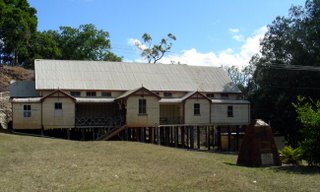 For a while, the town was a lively community. The School of the Arts, opened on Boxing Day 1900, kept the locals entertained. Among the amusements were shadow pantomimes, euphonium recitals and plays, including a dramatic sketch entitled 'A pair of lunatics'. X-rays were also a popular distraction. One show was described as a 'short lecture and practical demonstration, showing the bones of the hand, the contents of satchels and purses, and other mysterious effects.' The Walsh & Tinaroo Miner, which must have been the Sun of its day, said the show was 'most x-traordinary'.
For a while, the town was a lively community. The School of the Arts, opened on Boxing Day 1900, kept the locals entertained. Among the amusements were shadow pantomimes, euphonium recitals and plays, including a dramatic sketch entitled 'A pair of lunatics'. X-rays were also a popular distraction. One show was described as a 'short lecture and practical demonstration, showing the bones of the hand, the contents of satchels and purses, and other mysterious effects.' The Walsh & Tinaroo Miner, which must have been the Sun of its day, said the show was 'most x-traordinary'. 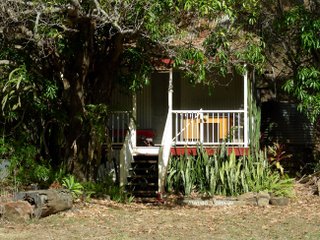 Like Herberton, the town attracted a succession of fascinating people. Dr Thomas Bancroft, resident medical officer at Stannary Hills in the early 1900s, worked on hookworm and dengue mosquitoes. He also collected plant specimens for the office of the colonial botanist. Dr William Evan MacFarlane, who took charge of the Walsh District Hospital at Irvinebank in 1906, built an observatory next to his house.
Like Herberton, the town attracted a succession of fascinating people. Dr Thomas Bancroft, resident medical officer at Stannary Hills in the early 1900s, worked on hookworm and dengue mosquitoes. He also collected plant specimens for the office of the colonial botanist. Dr William Evan MacFarlane, who took charge of the Walsh District Hospital at Irvinebank in 1906, built an observatory next to his house.Irvinebank is no longer the centre of the tin industry. But many of the buildings remain. I didn't spend long enough exploring the mining legacy. I will go back. It's too good to miss.